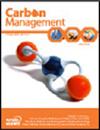通过木材轮作扩展增加碳储量的现实潜力:对太平洋西北地区的分析
IF 3.2
4区 环境科学与生态学
Q3 ENVIRONMENTAL SCIENCES
引用次数: 0
摘要
延长采伐轮作长度是一种通常提出的方法,以增加木材管理森林的碳固存。然而,一些限制限制了集约化管理森林的实际储存潜力。考虑到特定的限制,我们提出了一项分析,通过在美国太平洋西北地区(一个重要的木材产区)进行轮作扩展,增加碳固存的现实潜力。我们首先评估了长期木材产量下降的林龄对轮作长度的限制,然后纳入了树干直径超过合理采伐阈值的林龄。利用可公开获得的森林调查数据,我们对该地区的生长参数进行了实证建模,以用于本分析。尽管存在不确定性,但我们在华盛顿西部发现了一些轮作长度扩展的机会,这些轮作长度随子区域和木材种类的变化而变化,强调了地理和物种特异性生长参数对森林碳管理的重要性,即使在一般区域内也是如此。然而,与总排放量相比,在这种改进的森林管理情景下,实际的总封存潜力是很小的:在华盛顿州的情况下,估计累积的地上活生物量的额外封存将抵消一年的总排放量,而在景观上逐步实施的十年尺度的轮作延长,以避免商业木材生产的完全停顿,将需要一个世纪的时间才能实现。总的来说,实际考虑大大限制了这种碳封存策略的现实潜力。本文章由计算机程序翻译,如有差异,请以英文原文为准。
Realistic potential increases in carbon storage via timber rotation extensions: an analysis of the Pacific Northwest
Extensions of harvest rotation length are a commonly proposed method to increase carbon sequestration in forests that are managed for timber. However, several limitations constrain realistic storage potential in intensively managed forests. We present an analysis of the realistic potential for additional carbon sequestration via rotation extension across the Pacific Northwest of the United States, an important timber-producing region, taking into account specific limitations. We first assess the limitations on rotation length imposed by the stand age at which wood production would decline over the long term, and then incorporate the age at which trunk diameter surpasses a reasonable threshold for logging. Using publicly available forest survey data, we empirically model growth parameters across this region for use in this analysis. Despite uncertainties, we find some opportunities for rotation length extension in western Washington with variation by sub-region and timber species, emphasizing the importance of geography- and species-specific growth parameters for forest carbon management even within a general region. However, the total realistic potential for sequestration under this improved forest management scenario is small relative to gross emissions: the estimated cumulative additional sequestration in aboveground live biomass would offset one year of gross emissions in the case of Washington state, while a decadal-scale rotation extension implemented gradually over the landscape to avoid a total pause on commercial timber production would take on the scale of a century to achieve. Overall, practical considerations greatly limit the realistic potential of this carbon sequestration strategy.
求助全文
通过发布文献求助,成功后即可免费获取论文全文。
去求助
来源期刊

Carbon Management
ENVIRONMENTAL SCIENCES-
CiteScore
5.80
自引率
3.20%
发文量
35
期刊介绍:
Carbon Management is a scholarly peer-reviewed forum for insights from the diverse array of disciplines that enhance our understanding of carbon dioxide and other GHG interactions – from biology, ecology, chemistry and engineering to law, policy, economics and sociology.
The core aim of Carbon Management is it to examine the options and mechanisms for mitigating the causes and impacts of climate change, which includes mechanisms for reducing emissions and enhancing the removal of GHGs from the atmosphere, as well as metrics used to measure performance of options and mechanisms resulting from international treaties, domestic policies, local regulations, environmental markets, technologies, industrial efforts and consumer choices.
One key aim of the journal is to catalyse intellectual debate in an inclusive and scientific manner on the practical work of policy implementation related to the long-term effort of managing our global GHG emissions and impacts. Decisions made in the near future will have profound impacts on the global climate and biosphere. Carbon Management delivers research findings in an accessible format to inform decisions in the fields of research, education, management and environmental policy.
 求助内容:
求助内容: 应助结果提醒方式:
应助结果提醒方式:


